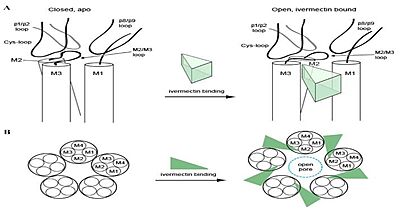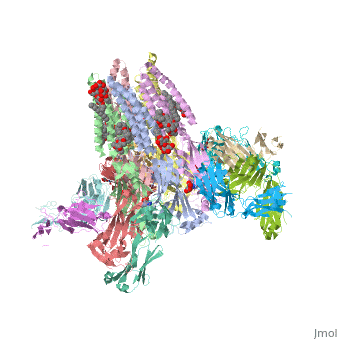Function
Ivermectin has a primary function as an anti-parasitic, and it does this by either stunning (vermifuge) or killing (vermicide) the parasites. [1] This works with many types of helminthiasis, which is an infection from parasitic worms. It is able to work in strongyloidiasis by killing the worms in the intestines. [1] In the case of the onchocerciasis, Ivermectin is able to inhibit the release of microfilariae from the female, but it is unable to kill the full grown worms. [2] A possible drawback from this treatment is the increased possiblility of toxicity due to the increase in antigen loads from the dead and dying parasites. [2] Ivermectin works on scabies by causing a discharge of gamma aminobutyric acid (GABA) near endoparasite’s nerve endings while also causing the affinity to GABA to increase in special receptors at synapses. As GABA is the chief inhibitory compound in the central nervous system, an increased affinity to these molecules can cause an interruption of nerve impulses, leading to possible paralysis or death. [3] This happens from an influx of chloride ions into the cells, which will lead to hyper-polarisation followed by paralysis and death. [4] Ivermectin remains safe for mammalian use due to the GABA receptors being located past the blood-brain barrier, compared to nematodes and arthropods that have GABA receptors in their peripheral nevous system at neuromuscular junctions. [5]
Structure
Ivermectin is a member of the avermectin group. In its normal form, Ivermectin is a crystalline powder that does not dissolve freely in water. [6] This fact makes it useful for interactions in the body because it won’t dissolve before binding to the parasite. Avermectin drugs are large molecules containing largely made of carbons, hydrogens, and oxygen. Avermectins are lactone rings, which are cyclic esters of hydroxycarboxylic acids. Avermectins typically have high affinity for negatively charged glutamate-gated channels[7]. The negatively charged channel increases the permeability because chloride ions are negative which allows them to flow through more easily. The influx of chloride ions paralyzes the parasite. Ivermectin is a combination of two different avermectins. It is primarily made up of 90% 5-O demethyl-22,23-dihydroavermectin A1a C48H74O14 and 10% 5-O-demethyl-25-de(1-methylpropyl)-22,23-dihydro-25-(1-methylethyl)avermectin A1a C48H74O14.[6] There is binding between the two separate molecules that keep them together and there are also different conformations of the molecule
Mechanism
Ivermectin binds with high affinity to the glutamate-gated channels that reside in invertebrate nerve and muscle cells [8]. In contrast to most , where binding of the ligand and the subsequent activation of the channel is permitted in the absence of the drug, Glutamate only binds to the homomeric GLC-1 receptor in the presence of a bound Ivermectin molecule. The ivermectin-binding site is located in the channel domain situated between the M3 and M1 membrane spanning domains of two adjacent subunits, where Ivermectin, in close proximity to the M2 spanning domain that extends throughout the interior of the ion channel, establishes contact with the M2 domain and the M2-M3 loop. The overlapping of the ivermectin-binding site and the binding sites of volatile drugs and anesthetics that operate at mammalian GABA and glycine receptors, indicates that Ivermectin binding to this site may induce conformational alterations to the glutamate-binding site as a result of Ivermectin’s interaction with the M2-M3 loop. These conformational adaptations could engender allosteric modifications in structure, and Ivermectin’s interactions with M2 residues may secure the channel in the long-lasting open configuration that is distinctive of the binding arrangements associated with these drugs. Although the highly cooperative nature of the glutamate responses propose that multiple bound Ivermectin molecules are required to open the channel, or potentiate the glutamate response, it is not specifically known how many Ivermectin molecules are needed to initiate these responses. However, the slow opening of the channel is a mechanistic consequence that can be attributed to Ivermectin binding at the overlapping site [9]

Figure 2 Ivermectin binds between the membrane-spanning domains, M1 and M3, of two adjacent subunits, typically pushing the membrane-spanning regions of the subunits in opposite directions, and thus, initiating the opening of the channel. The transmittance of allosteric signals to the ligand-binding site is engendered by Ivermectin’s contact with the M2-M3 loop and other regions of the extracellular domain. [9]
Ivermectin’s high binding affinity for the glutamate-gated chloride channels present in nerve and muscle cells augments the cell membrane’s permeability to chloride ions, which is then coupled with hyperpolarization of the nerve or muscle microfilarial cells. Paralysis, or even death, can be induced as a result of hyperpolarization, either as a direct consequence, or through starvation. However, one study proposes a depolarizing, as opposed to a hyperpolarizing, role of Ivermectin in relation to the glutamate-gated channel. Regardless of the polarizing role that Ivermectin assumes, the manipulation of chloride levels engenders the deactivation of the channel as a result [8].
The selectivity associated with this division of compounds can be attributed to the absence of glutamate-gated chloride channels in some mammalian species, in concurrence with the low affinity that avermectins possess for mammalian ligand-gated chloride channels. Furthermore, Ivermectin does not readily traverse through the blood-brain barrier in humans, due to its inability to penetrate this barrier, and instead, impacts general circulation by targeting its antiparasitic activity [8].
There is reason to believe that Ivermectin is agonistic in nature, a term that denotes a substance that initiates a physiological response when combined with a receptor. Ivermectin’s agonistic nature can be linked to its interaction with the neurotransmitter gamma-aminobutyric acid (GABA), in which it disrupts and obstructs GABA-mediated central nervous system neurosynaptic transmission. The impairment of normal intrauterine development of O. volvulus microfilariae and the impedance or restriction of their release from the uteri of gravid female worms has also been traced to ivermectin [10].
Diseases in Humans
River Blindness
Onchocerca volvulus is a vector-borne filarial nematode parasite. The parasite is found in West Africa, Latin America and the northern part of South America. Onchocerciasis is one of the major causes of river blindness in Africa. Symptoms includes intense itching of the skin and the appearance of a rash. Eventually the affected skin can become edematous and take on an orange-peel quality. With the eyes, initially there will be conjunctivitis and photophobia and eventually sclerosis which is the main cause of the blindness.[2]
Strongyloidiasis
Strongyloides stercoralis is a parasitic nematode found throughout the world but is found mostly in tropical and subtropical regions. In immunocompetent individuals the disease comes across as watery diarrhea and constipation which lasts for six weeks until immunity develops. Children that contain the parasite develop a syndrome of anorexia, cachexia, chronic diarrhea, abdominal distension and impaired growth. Through the worms’ migratory phase the symptoms are similar to that of ascariasis and hookworm disease of pneumonitis. There is a high risk of auto-infection so if one is not treated for the infection, one will remain infected for life.[2]
Head Lice
The usual symptom of all lice (Pediculus humanus capitis) is intense itching and can lead to a secondary bacterial infection due to constant scratching. The bites from head lice results in inflammatory papules and lesions associated with lymphadenopathy. With heavy infections, the head lice can cause a condition where the hair, eggs can form a cap-like mass full of lice. When children are infected with lice, they appear restless.[2]
Scabies
Scabies is a human skin disease caused by the mite Sarcoptes scabiei. The disease is associated with crowded living conditions. The symptoms include nocturnal itching and lesions.[2]
Elephantiasis
Elephantiasis- Wuchereria bancrofti is a thread like nematode found in the tropics of South Asia, Africa and tropical regions of the Americas. Elephantiasis is a disfiguring disease that is caused by the blockage of the lymphatic vessels.The disease is characterized by lymphedema of the arms, legs, breasts, and genitalia. Through the inflammation the skin loses its elasticity.[2]


